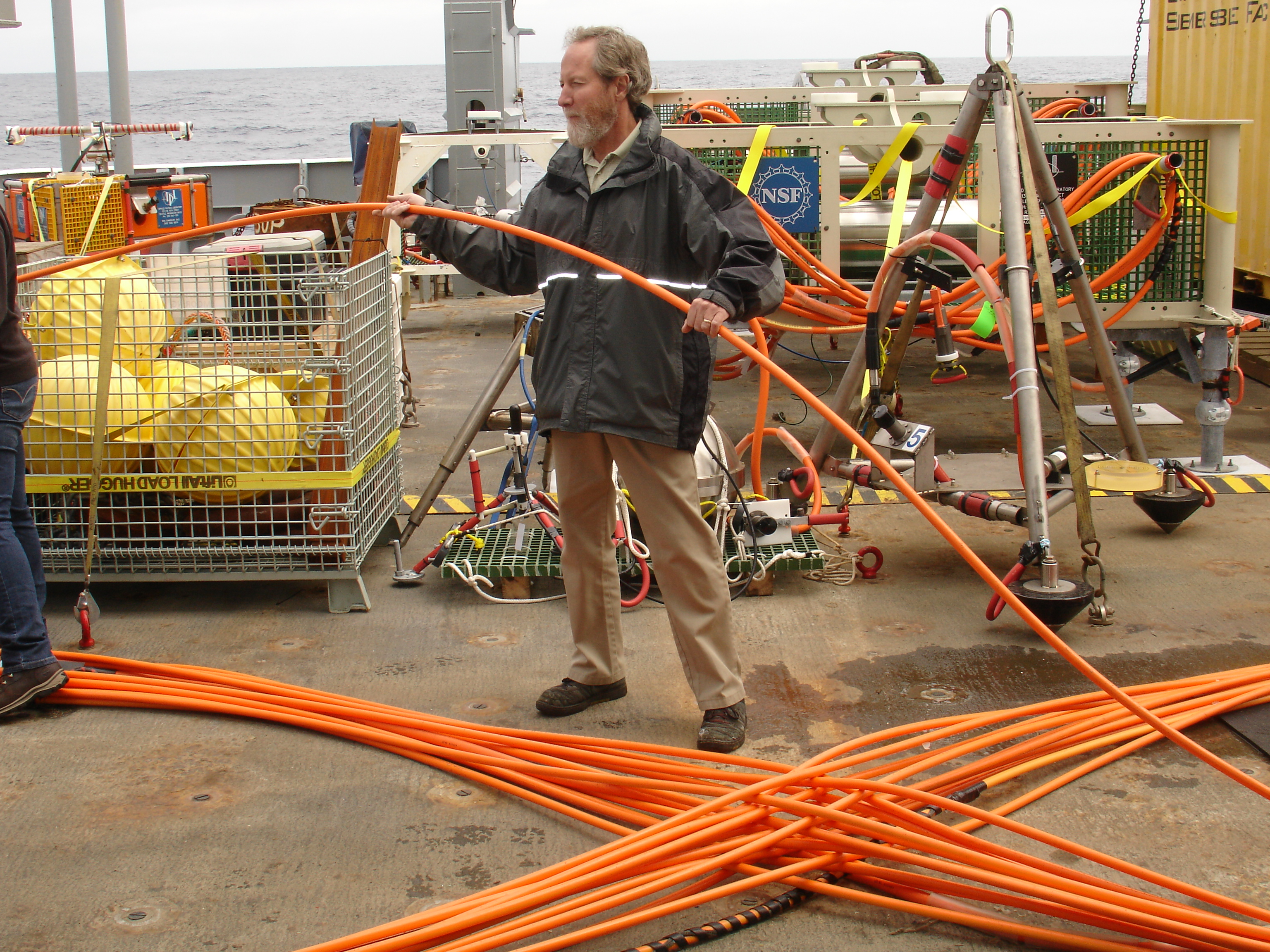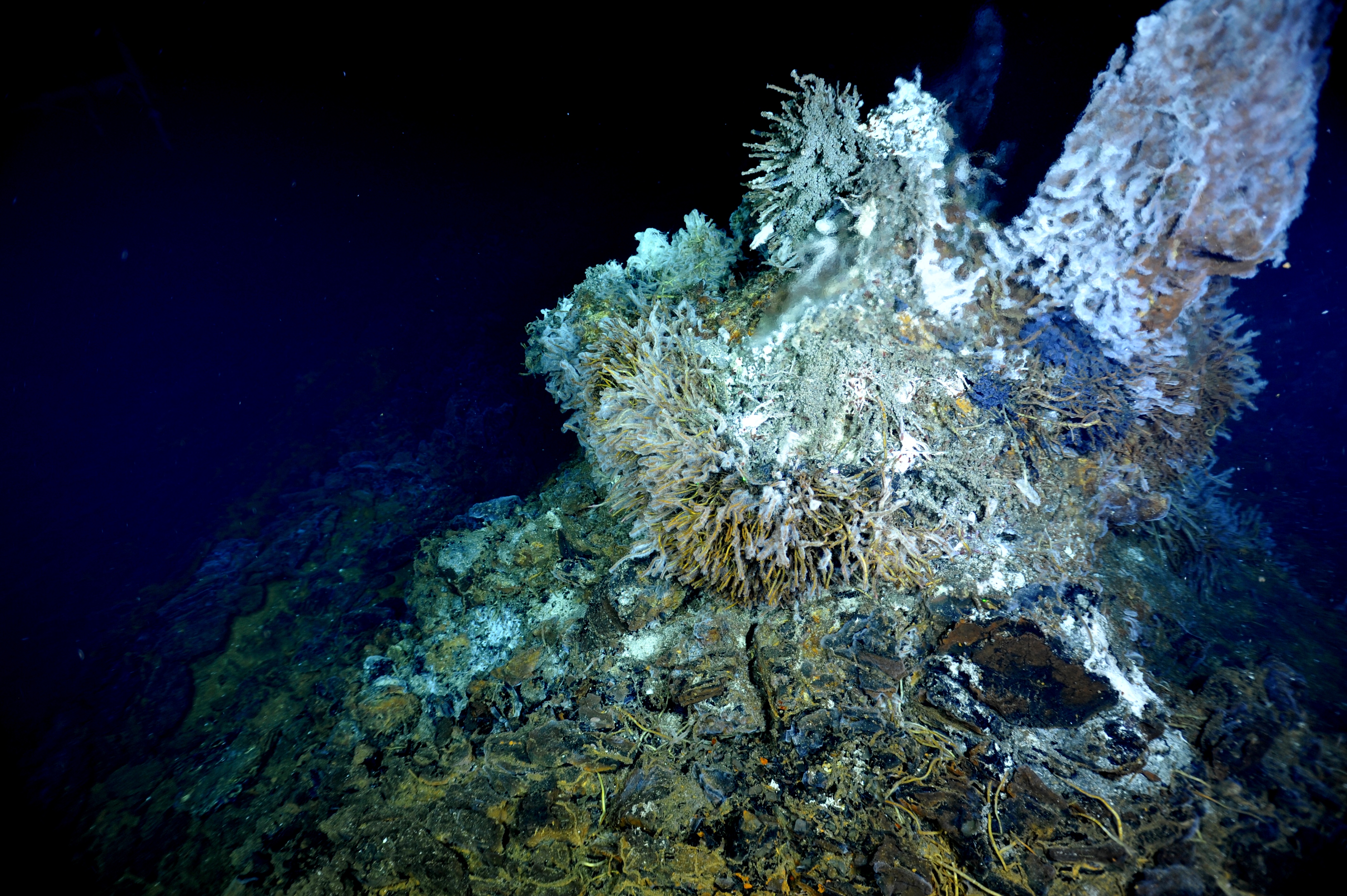Image Archive





























ROCLS with 4.7 km of extension cable, which was laid on Axial, from Primary Node PN3B to the Central Caldera. Photo credit: Christina Ramirez, University of Washington, V14.

The broadband seismometer (left) and low frequency hydrophone (right) are installed on the floor of Axial Seamount at the Central Caldera Site. The 7-function manipulator of ROPOS is connecting the extension cable to the medium powered junction box. The white bags inssulate the broadband from acoustic "noise" associated with curents flowing over the instrument.

A holothurian Deep Sea Cucumber (possibly of Genus Pannychia) at 5000 ft is surrounded by brittle stars and a sea spider (bottom right). Photo credit: NSF-OOI/UW/CSSF; Dive R1727; V14.

Skip Denny's dragon brought good luck on a ROCLS cable installation during VISIONS'14. Photo Credit: Debbie Kelley, University of Washington; V14.

Meet the star of the VISIONS '14 movie, the robotic vehicle ROPOS - powerhouse of the operations during VISIONS 14. Photo credit: Christina Ramirez, University of Washington, V14.

Finding a quiet place on a busy ship to record a voice-over for video isn't easy. Here, UW students Sam Albertson, Katie Bigham and Jesse Turner work in the ship's hold. Photo credit: Gina Hansen, University of Washington, V14

During Leg 1 of the OOI-NSF VISIONS'14 Expedition, we are making significant progress in the installation of secondary infrastructure at the summit of Axial Seamount. Infrastructure shown in green is deployed on the seafloor. During ROPOS Dive R1727, the ~ 4.6 km extension cable from PN3B to MJ03F at Central Caldera will be installed, completing this site. Image Credit: University of Washington, V14.

A marker deployed on ROPOS Dive R 1725 marks the installation location for the broadband seismometer and low frequency hydrophone at the Central Caldera Site. Photo credit: NSF-OOI/UW/CSSF; Dive R1725; V14.

John Wonderly, a teacher from Clallam Bay School, assists with the respooling of 250 m of cable onto the ROCLS drum. This cable totals 4.7 km in length and will be laid on the seafloor to connect Axial Caldera's Primary Node PN3B with the Central Caldera Secondary Node. Photo Credit: Leslie Sautter, College of Charleston, V14.

During ROPOS Dive R1724, the junction Box MJ03F was deployed at the Central Caldera Site. It will host a broadband seismometer, a low-frequency hydrophone, and a bottom pressure-tilt instrument suite. Photo credit: NSF-OOI/UW/CSSF; Dive R1726; V14.

The remotely operated vehicle ROPOS is launched from the R/V Thompson. ROPOS will dive to 5000 ft beneath the ocean's surface to the summit of Axial Seamount. Today the ocean in the NE Pacific is calm. Photo credit: NSF-OOI/UW/CSSF; Dive R1726; V14.

A current meter is held in the manipulator of the ROV ROPOS for installation at the International District 2 Site. Photo credit: NSF-OOI/UW/CSSF; Dive 1723; V14.

A low-frequency hydrophone (black tubular-shaped instrument in tripod with red legs), connected to a broadband seismometer, awaits installation by the ROPOS that will install this sensor in the International District 2 Site. Pea gravel bags in the background will be piled over the broadband to dampen any noise by local currents. Credit: Mitch Elend, University of Washington, V14.

The entire crew turns out for hand spooling ~800 ft of extension cable back onto the ROCLS drum that was recovered from the seafloor. Hard work, but lots of smiles. Photo credit: Mitch Elend, University of Washington, V14.

A bottom pressure-tilt instrument is installed at the summit of Axial Seamount in the International District hydrothermal field. This instrument measures the rise and fall of the seafloor due to melt migration in the subsurface. Currently, the seafloor is rising and this is believed to reflect the influx of magma into the core of the volcano.The instrument rests on a frozen lava flow - called a sheet flow. The small black marble in the yellow plate at the instrument base indicates that the platform it level. Photo credit: NSF-OOI/UW/CSSF; Dive R1723; V14.

A bottom pressure-tilt instrument is installed at the Eastern Caldera Site on the summit of Axial Seamount. Image Credit: VISIONS'13, UW/OOI/CSSF; Dive R1617; V13.

A broadband seismometer installed at Eastern Caldera is coupled to a low-frequency hydrohone. Bags of pea gravel decrease "noise" from currents. Credit: UW/NSF-OOI//CSSF; ROPOS Dive R1722; V14.

University of Washington undergraduate students learn how a CTD works, the science behind this instrument package, and how to take water samples during the VISIONS'14 expedition. Image Credit: Mitch Elend, University of Washington; V14.

VISIONS'14 undergraduate students use the bow of the R/V Thompson for their outdoor study session. Image Credit: Leslie Sautter, College of Charleston; V14.

A rattail fish (Coryphaenoides acrolepis) is a common site at the summit of Axial Seamount. Credit: UW/NSF-OOI/CSSF; Dive R1720; V14.

A short-period seismometer was installed and connected to a junction box in the International District hydrothermal field at the summit of Axial Seamount. Photo credit: NSF-OOI/UW/CSSF; Dive R1719; V14.

A beautiful octopus sits atop a ledge at the base of the hydrothermal vent called Escargot in the International District hydrothermal vent field at Axial Seamount. Credit: UW/NSF-OOI/CSSF; ROPOS Dive R1719; V14.

On July 20, the medium-powere junction box MJ03C was installed in the International District hydrothermal vent field on ROPOS Dive R1717. It was connected to a ~2300-m-long cable (RSO3W6) that will connect this system to Primary Node PN3B. A temperature-resistivty sensor (TRHPHA301) is inside the J-Box, awaiting installation during a follow-on dive. Photo credit: NSF-OOI/UW/CSSF; Dive 1717; V14.

On July 18, 2014 the Low-Voltage Node LV03A was deployed at Axial Base. It was moved on R1715 to its final location. It will provide power and communications to two moorings to be installed at this site. Primary Node PN3A is to the right. Photo credit: NSF-OOI/UW/CSSF; Dive R1714; V14.

El Gordo, at International District, is a site for Regional Cabled Array instrumentation in 2014. Brown tubes are stressed tubeworms covered in filamentous bacteria. Credit: UW/NSF-OOI/CSSF; ROPOS Dive R1719; V14.

Ciliates, purple single-celled Protists, colonize the base of Escargot hydrothermal vent. Credit: UW/NSF-OOI//CSSF; ROPOS Dive R1719; V14.

The large pink octopus (likely Muusoctopus sp.) sits on a ledge at Escargot hydrothermal vent in the International District Hydrothermal Field. Credit: UW/NSF-OOI/CSSF; ROPOS Dive R1719; V14.

Medium-Power Junction Box MJ03C rests on the platform for ROPOS, awaiting connection to the underbelly of ROPOS. This node was installed on the seafloor during dive R1717.
- Anemone
- Animal
- Arthropod
- ASHES
- Axial
- Axial Base
- Axial Biology
- Axial Caldera
- Bacteria
- Basalt Lava
- BEP
- Biofouling
- biolgoy
- Biology
- Camds
- Camera
- Camhd
- Central Caldera
- Ciliates
- Cnidaria
- Coastal Biology
- Crab
- Deep Profiler Mooring
- Dive Highlights
- Eastern Caldera
- Echinoderms
- Endurance Array
- Engineering Team
- ENLIGHTEN 10
- Exploratorium
- Fish
- Geology
- HD Camera
- HPIES
- Hydrate Ridge
- Hydrates
- Hydrophone
- Hydrothermal Vents
- Illustration
- Inshore 80 Meters
- Instrument
- International District
- J-BOX
- Jason
- Jellyfish
- Junction Box
- K12
- Lava
- Mollusk
- Moorings
- Nodes
- Nudibranch
- Octopus
- OOI
- Oregon Offshore
- Oregon Offshore 600 m
- Oregon Shelf
- Oregon Slope Base
- People
- PN1B
- PN1D
- Polychaetes
- PPSDN
- Primary Node
- RASFL
- ROCLS
- ROPOS
- ROPOS Dives
- ROV Team
- RV Revelle
- RV Sikuliaq
- RV Thompson
- Salp
- Sample
- SC13
- Science Team
- Sea Cucumber
- Sea Star
- Sea Urchin
- Seafloor
- Seismometer
- Sensors
- Shallow Profiler Mooring
- Shark
- Shipboard
- Shore Station
- Slope Base
- Smoker
- Soft Coral
- Southern Hydrate Ridge
- Sponge
- Squid
- Students
- Students & Guest Participants
- Tmpsf
- Tubeworms
- VISIONS 11 Leg 1
- VISIONS 11 Leg 2
- VISIONS 11 Viewers
- VISIONS 13
- VISIONS 14
- VISIONS 15
- VISIONS 16
- VISIONS 17
- VISIONS 18
- VISIONS 20
- VISIONS 22
- VISIONS 23
- Visualization
